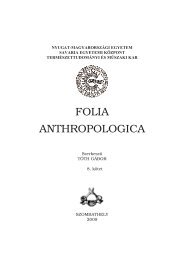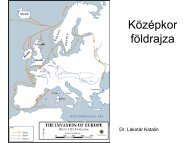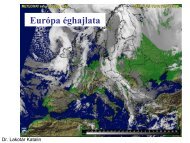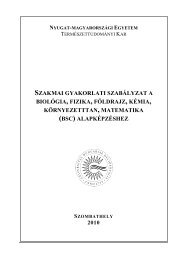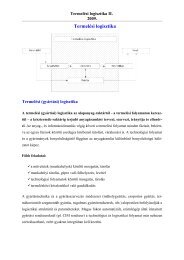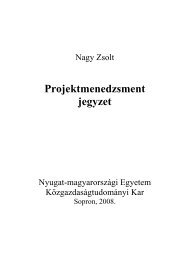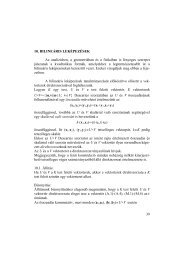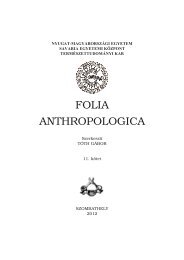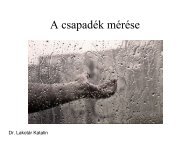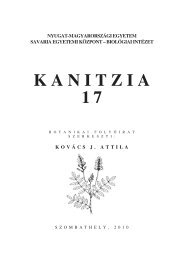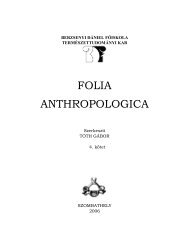Kanitzia 18. - NYME Természettudományi Kar - Nyugat ...
Kanitzia 18. - NYME Természettudományi Kar - Nyugat ...
Kanitzia 18. - NYME Természettudományi Kar - Nyugat ...
Create successful ePaper yourself
Turn your PDF publications into a flip-book with our unique Google optimized e-Paper software.
Orban”) is situated in the village area of Miheşu de Câmpie (Mezőméhes), former included<br />
in the village Răzoare (Mezővelkér), neighboured of Şăulia (Mezősályi) and accesible from<br />
there. The presence of K. ceratoides on the dry, sunny steep slopes and landsliding area of<br />
the hill „Coasta lui Orban” have already been recorded by BĂDĂRĂU et al. (2002). The authors<br />
demonstrated that the continuing landslides processes, the sunny places, dry slopes<br />
developped on sand and marly outcrops ensured the main habitat conditions for the species,<br />
which require mostly open places and cannot support well the closed dry grasslands and<br />
the overgrazing effects. Presently it can be observed a trend of positive naturalness process<br />
for the K. ceratoides population-stands, due to the succesful forest plantation program and<br />
after the limited grazing pressure. The typical landslides, the sunny steep slopes are occured<br />
by K. ceratoides population-stands, peculiar micro-areas where the main forest species<br />
planted cannot resist, but their climatic effects are still favourable. In this area the early<br />
plantations with woody species (1970-1973) was not a succesful intervention trial, the land<br />
use remained as an extensive pasture (sheeps, horned cattles) area. The second experimental<br />
plantation (2003-2004) has been realized with succes, because all degraded field territories<br />
have been fenced and closed for pasturing. The various species used for plantations, today<br />
occupy significative surfaces especially by the species of Pinus nigra and Robinia pseudoacacia,<br />
followed by Amorpha fruticosa, Eleagnus angustifolia, Prunus serotina, Hippophaë<br />
rhamnoides, Acer platanoides, A. pseudoplatanus, Fraxinus excelsior etc., totaly ensuring<br />
suitable protection areas for the K. ceratoides populations. Nevetheless in some places,<br />
under the protection of the planted species, other common taxa are spreading more and<br />
more: Prunus spinosa, Crataegus monogyna, Calamagrostis epigeios, Phragmites australis<br />
etc., which stands can limit in the future the survival and preservation of K. ceratoides populations.<br />
3. The site near the locality Poiana Frăţii (Bethlentanya) (site name „Onisie”) is<br />
situated just in the forest steppe area of the central-southern part of the Transylvanian Lowland.<br />
From the main village Frata into the south-eastern direction, especially toward to<br />
the localities Oaş (Avas), Poiana Frăţii (Bethlentanya) and Miheşu de Câmpie (Mezőméhes)<br />
is a large landslide and eroded hilly region with dry and steppic grasslands, abandoned<br />
lands, small groups of mixed oak forests, field crops and wood plantations. The large pasture<br />
areas are intermitted sometimes by woody plantations and old landslides. At a distance<br />
of cca 3 km east from the locality Poiana Frăţii, the pasture field broken by a woody plantation<br />
(Pinus, Robinia) and deep land erosion, near a small brook forming narrow valley,<br />
ravine, gorge-like or narrow little canyon landscape aspect on clay and marle, is found the<br />
site with steep slopes favourable for establishing the K. ceratoides populations. Generally<br />
the characteristic stands bordering the woody plantation and the small brook, where they<br />
are relatively protected against the pasture animals, while the open field popu-lations are<br />
regulary disturbed. The site is located at cca 15 km in north-west from the former site<br />
(Groapa Rădăii), so the relative similarity of the climate conditions is very significant. The<br />
development and the maintenance of the K. ceratoides stands here is influenced by the<br />
strong grazing pressure, slope erosion, landslide processes, spreading woody and weed<br />
species, trampled pathways, ploughed lands etc.<br />
64




